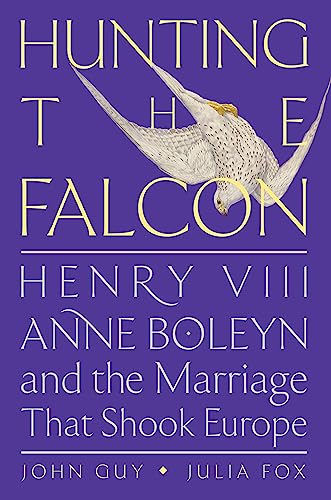Hunting the Falcon: Henry VIII, Anne Boleyn, and the Marriage That Shook Europe

“John Gay and Julia Fox, in Hunting the Falcon, demonstrate the vast tapestry of the stories within the greater legend of Henry VIII by concentrating on his relationship with Anne Boleyn.”
After the story around Julius Caesar and all that entailed, the most epic story of family and relationships is that of Henry VIII. Both stories have general public histories, are celebrated in the entertainment media, and are a little-known, mind-numbingly complicated historical reality.
John Gay and Julia Fox, in Hunting the Falcon, demonstrate the vast tapestry of the stories within the greater legend of Henry VIII by concentrating on his relationship with Anne Boleyn. This issue is represented by the long list of characters at the beginning of the book to help the reader keep the players straight.
As with much modern scholarship, the authors seek to do more than retell a famous tale in their style. They try to offer “fresh archival discoveries, along with sources hidden in plain sight.” Important information on even Anne’s year of birth has only turned up since 2004! New readings have been made of a still partially unintelligible but important letter by Boylen. Modern views on the perception of aristocratic women’s roles in those years influence the narrative in Hunting the Falcon.
The authors have much to work with. The prologue chapters involve accidental kings, civil wars, illegitimacy, international politics, marriages awaiting the age of consent, and underage monarchs. It was a “game of thrones,” with the Vatican thrown in, and more about diplomatic marriages than battles to decide the shaky claims to power.
The story is one of high drama. Where this part ends with the beheading of Anne Boleyn on charges of “incest, quadruple adultery, and plotting to kill her husband” Henry VIII, the execution becomes the prologue to the next phase of the continuing epic. The crime is not the story, however, but how “barely three weeks before, she had been the most influential woman in the country.”
Executions, intrigues, and power are described around politics and sex. Even ballads, poetry, and enormous galas around courtly love represented power and sex among royals. Throughout the story, from Henry VIII to the end of the reign of Boleyn’s daughter, Elizabeth I, the common thread is “dynastic security” that evolved into national identity and safety under threat at home and abroad.
Henry VIII, who was never intended to be king, married his older brother’s widow, Katherine of Aragon, undid the marriage, married her again, and famously divorced her. His subsequent marriage to Anne Boleyn was no less complicated.
Guy and Fox devote chapters to the Boleyn (or de Boullan) family, probably among the most famous social climbers in history. The Boleyns came from common merchant roots and became rich over generations, “just not rich enough.” For generations, they maneuvered not just to obtain power and prestige but also even more wealth to finance more power and prestige.
Anne would serve in the courts of the Netherlands, France, and England before a complicated series of events found her, finally, as the wife of Henry VIII. As a young woman in the court of Margaret of Austria, she was “observing at first hand a politically agile woman exercising power as a regent.” Over seven years, she was unknowingly mentored for her role as a future queen in the court of Queen Claude of France, including regarding dowries, rule, royal heirs, and sexual relations.
Henry and Anne had been raised to rule in princely courts. The future king learned “the dark underbelly of politics, with underlings too venal or frightened to challenge the king,” his controlling, manipulative, tyrannical father, Henry VII. The son “discovered fear to be a proven method of control,” how fragile power could be, and how his father “operated on the margins of the law while still managing to stay within it.”
The pieces were in place before Henry first noticed Anne. Her father and son profitably served the king, and her sister Mary was Henry’s mistress. Some regarded Anne as an exotically beautiful woman, “but a social gulf still separated” Boleyns, well-known as descendants of textile merchants, from prominent families such as the Percys.
Anne Boleyn served in Queen Katherine’s household as a twenty-one-year-old lesser maiden. “She was never the prettiest woman at court.” Her love life had been handled by men and had been a disappointment; her initial attraction to Henry as potentially another mistress may have only been because she was a Francophile when Henry wanted a better relationship with France and a legitimate male heir.
To be a courtesan with the security of a husband, as her sister had been, was not an option for the single Anne Boleyn. She would be Henry’s queen and, as Queen Katherine had been in the first years of her marriage, reign with him, not just make his babies. As the story famously tells, that required Henry to obtain a divorce, which led to separating the Church of England from the Vatican and freeing Henry to sell the Church’s English holdings to cover his debts.
Circumstances gave Anne Boleyn all she could have dreamed of but also took it all away, literally. Henry was changing, sinking into paranoia, and increasingly less interested in any advice. Her failure to give him a male heir proved her end. Boleyn’s execution created problems for Henry VIII that became the saga of wives three through six.
Hunting the Falcon is not large and confusing like War and Peace, but it is a big book well-designed to make reading easier. The narrative is a good read that entertains the reader, even when telling a familiar tale, with relevant detail and color to help the reader understand the people and times. This work has annotation, a bibliography, and color illustrations.